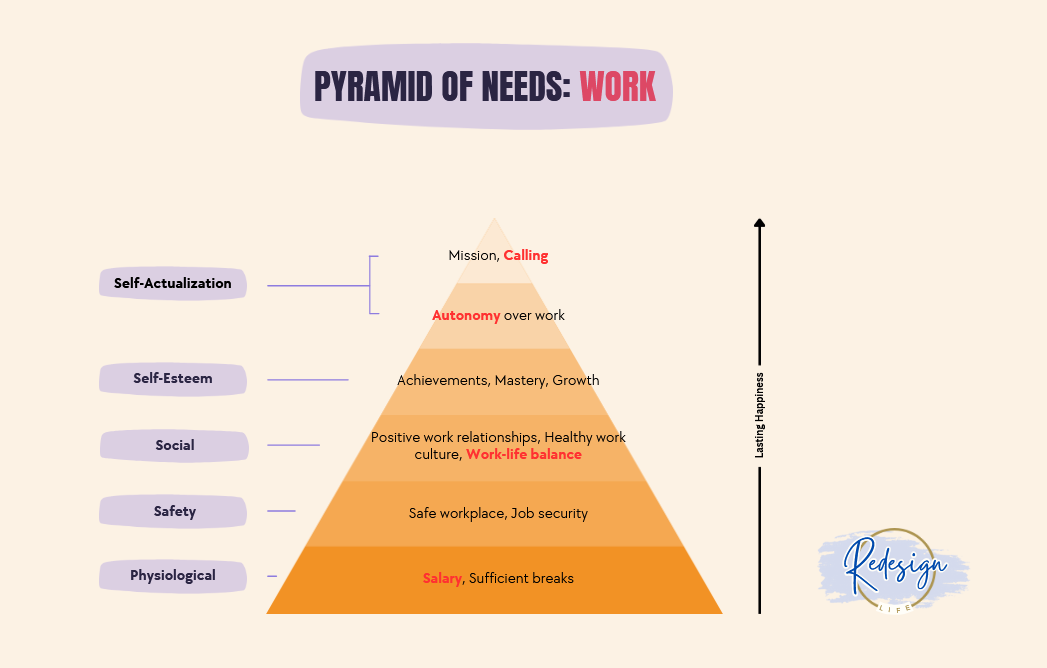Jobcrafting 101: Design Your Dream Job

Flexible schedule. Purpose. Freedom.
We all want a dream job that fits our life, not the other way around.
The good news? Dream jobs are built, not found.
Most professional jobs aren't 100% strict on the role. In other words, you can shape your job over time to better match your values, passions, and life's needs.
This is a practical idea called jobcrafting.
Why Bother?
Because you're going to spend 100,000 hours of your life working.
Let’s be clear: not every job can become a "dream job". Some jobs are quite rigid, others more flexible. Still, any job can be made better.
Even small improvements can compound into a huge difference over all those hours.
See What You Have and What’s Missing
Start by figuring out where you stand on the pyramid of needs for work happiness.
At the base are lower needs:
- income for basic needs
- a safe workplace
- strong relationships with coworkers
Higher needs:

Chances are, if you're a professional, your lower needs (such as income) are mostly met.
If you're unhappy with work, it’s more likely due to unmet higher needs such as autonomy, growth, or purpose.
- Do you feel a lack of control over your work?
If so, you need more autonomy – the freedom to choose when, where, and how your work is done. - Do you feel uninspired and stuck in the same routine?
Then you need growth. - Do you feel like your work lacks meaning?
It’s time to uncover your calling. Reconnect with your 'why'
Once you know what’s missing, you can begin to jobcraft.
Jobcrafting Has Two Ongoing Processes
- Advocate for your needs: take small, strategic steps to change aspects of your job
- Consistently create value for your employer: make yourself indispensable
- Rinse and repeat
1) Advocate for Your Needs
As a professional, you've dedicated years to learn specialized skills. This makes you very valuable in the job market.
The more valuable you are, the more leverage you have to change aspects of your job.
This does not mean barge into your employer’s office and demand sweeping changes.
Make It Easy For Your Employer To Say Yes
- Start small
“Could I block off the first work hour so that I could work on high-priority tasks?” - Look for a win-win
“If I could shift my hours slightly, I’d be more available during peak client times.” - Suggest a trial period
“Can we try one remote work day a week for a month and assess the results?” - Ask with curiosity, not confrontation
“What would it take to build more flexibility into my schedule?” - Earn trust before asking
When you’re known for being reliable and thoughtful, it’s easier for others to say yes.
Think of a small, realistic ask that moves your job closer to what you want.
Then go for it!
2) Consistently Create Value
Over the long run, your soft influence grows as you consistently create value for others.
This means:
- Going beyond your job description when it makes sense
- Showing initiative
- Growing your skills (courses, certifications, coaching)
- Cultivating soft skills—being agreeable, kind, helpful, and reliable
Stick with it long enough, and you become indispensable.
Think about that go-to person in every organization:
The one who solves hard problems.
Who keeps morale up.
Who helps coworkers even when they don’t have to.
Those are the people employers bend over backwards to retain. They often get first pick of projects, more flexibility, and more say in how they work.
In other words, when you create value, you become more valuable.
And that opens the door for bigger, more meaningful changes to your role.
This is how you jobcraft your way toward your dream job — one small step at a time.
Your Job Should Energize You, Not Drain You.
You have more power than you think to shape your job.
Feeling unsure? That’s normal. The first step is always the hardest.
Here's what you do next:
Ask for one small change to an aspect of your job that matters to you.
This article is the zoomed-in view of job happiness. In Part 2, we’ll zoom out to look at the big picture — building your ideal career.
For a real-world example of jobcrafting, check out Dr. Rena — an optometrist who transformed a traditional clinic job into a flexible, work-from-home role:

⭐ I love sharing ideas about work-life happiness. Let's connect! ⭐






Member discussion